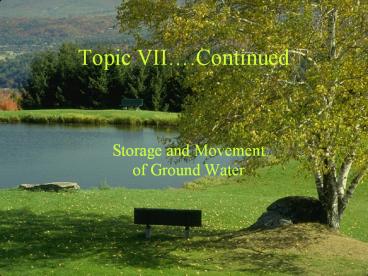Topic VII - PowerPoint PPT Presentation
1 / 14
Title:
Topic VII
Description:
Topic VII .Continued Storage and Movement of Ground Water Porosity and Permeability Porosity -A measure of the amount of air space within a soil is known as porosity. – PowerPoint PPT presentation
Number of Views:93
Avg rating:3.0/5.0
Title: Topic VII
1
Topic VII.Continued
- Storage and Movement of Ground Water
2
Porosity and Permeability
- Porosity -A measure of the amount of air space
within a soil is known as porosity. A soil of
high porosity means that there is a great deal of
air space between soil particles. - Permeability - If the air spaces within the soil
are interconnected, water can flow through the
rock and soil and the material is said to be
permeable
3
Material can be porous without being permeable,
but it cannot be permeable without being porous.
Porous, but not permeable
Porous and permeable
4
FACTORS AFFECTINGPorosity..
- Shape of particles -
- .the more well rounded the particles within a
soil or rock sample are, the more porosity the
sample has. - Size distribution -
- If all particles are the same size, there is
more porosity than if the particles are of mixed
sizes
5
Shape of particles.
Angular
Well rounded
6
FACTORS AFFECTING Permeability.
- The larger the grain sizes, the more permeable
the material - The more homogeneous the material sizes, the more
permeable the soil is - Generally, the more well rounded the material is,
the more permeable it is.
7
Regions of Groundwater
8
Note the following regions of groundwater.
- Zone of Aeration - the upper zone of ground where
pore spaces are NOT all filled with water. - Zone of Saturation - the lower layer of ground
where all pore spaces are filled with water.
9
In the Zone of Aeration,
- It is composed of 3 regions.
- 1 - The uppermost regions where water forms a
film around grains of topsoil(soil water) - 2 - The Capillary Fringe which lies just above
the water table and draw water up from the zone
of saturation. - 3 - the middle zone which remains relatively dry.
10
The Water Table
- The water table is the topmost layer of the zone
of saturation. - The water table will rise and fall with
topography, with seasons, and with use.
11
Ordinary Wells and Springs
12
Ordinary wells
- Must penetrate deeply into highly permeable rock
and sediment. - If the well is not deep enough, the well may run
dry during the summer months. - As water is pumped out of such a well, a cone of
depression forms in the water table. If this
depression goes lower than the well, the well
runs dry.
13
Artesian Wells and Springs...
14
Artesian Wells.
- Require a sloping permeable layer of rock which
often runs hundreds of miles under ground. The
layer is known as an Aquifer - Water collects in an area of high elevation in
the exposed area of an aquifer and is then
carried down underground by gravity. - The aquifer acts as a hose. When you tap into
the hose, the water flows under its own pressure.































